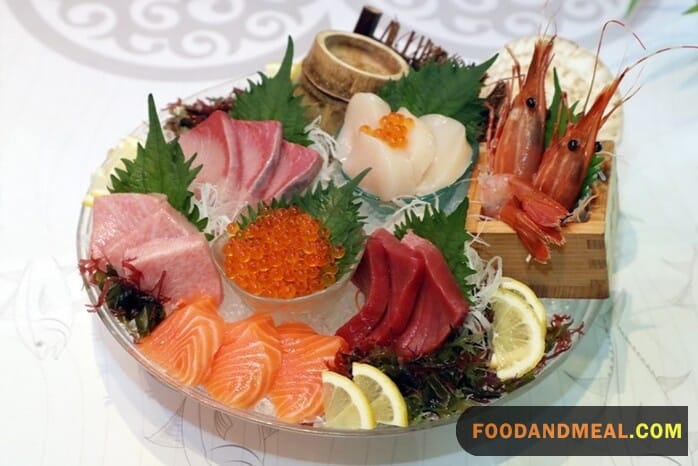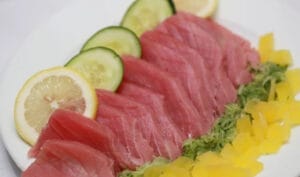I’m James Anderson, and so excited to share my new sashimi recipe with you all! As an avid home cook and employee at Food And Meal, I have a deep passion for creating delicious yet simple dishes.
Lately I’ve become completely obsessed with sashimi. There’s just something about the freshness of the raw fish paired with the perfect garnishes that excites my palate. The light and healthy nature of the dish also appeals to me. I’ll admit, I was intimidated at first about preparing sashimi at home. But once I tried it myself and realized how easy it can be with high quality ingredients and the right tools, I was hooked!
So, How to make.Sashimi ? . Now I try to make sashimi at least once a week. It’s a nice change of pace from my usual hearty comfort food meals. Plus it makes me feel like I’m dining at a high-end sushi restaurant without leaving my kitchen! I especially love experimenting with different white fish like halibut, sea bass and fluke beyond the typical tuna and salmon.
In this post, I’m going to walk you through my favorite simple sashimi recipe, as well as provide plenty of tips for sourcing sashimi-grade fish and how to slice it properly. My goal is to demystify the process so you too can start enjoying this light, fresh and elegant dish in your own home. I hope this recipe brings you as much happiness as it does for me. Let’s get started!
How to make.Sashimi
Sashimi is a popular Japanese dish that consists of slices of raw meat and fish. This food is usually served with soy sauce. Sashimi is considered to be the national dish of Japan. It is often eaten with a small amount of soy sauce. It is considered to be the best way to experience the true essence of Japanese cuisine. In order to truly enjoy salmon sashimi, you should try it at least once in your lifetime.


Sashimi
Ingredients
- 1 pound fish salmon, tuna, snapper, yellowtail, etc., must be fresh, Sashimi- grade
- 1 carrot grated, for garnish
- 1 daikon grated, for garnish
- Soy sauce Wasabi
- Sushi ginger gari
Instructions
- Freeze the fish so it is firm enough to cut thinly.

- Use a very sharp, non-serrated knife to remove the skin.

- Cut into M-inch thick pieces, about the size of a domino. Your knife should be sharp enough to prevent using a sawing motion that will destroy the flesh.

- Arrange on a platter and garnish with grated daikon and carrot.

- Serve with soy sauce, wasabi, and sushi ginger or gari.

Video
Notes
Nutrition
© Food And Meal
This website provides approximate nutrition information for convenience and as a courtesy only. Nutrition data is gathered primarily from the Spoonacular Database, whenever available, or otherwise other online calculators.
Alternative Method: Sashimi Salad Bowl

Ingredients:
- 8 ounces of the freshest sashimi-grade fish (salmon, tuna, or your choice)
- 2 cups of sushi rice
- 1 cucumber, thinly sliced
- 1 large avocado, thinly sliced
- 1/4 cup pickled ginger
- 1/4 cup soy sauce
- 2 tablespoons wasabi
- 2 tablespoons sesame seeds
- 1 tablespoon rice vinegar
- 1 tablespoon mirin
- Fresh seaweed salad for garnish (optional)
- Edible flowers for garnish (optional)
Instructions:
- Prepare the Sous-Vide Bath: Fill a large container or sous-vide water bath with water and set your sous-vide machine to 118°F (48°C). This temperature is slightly higher than traditional sashimi, but it’s perfectly safe for sous-vide cooking.
- Sous-Vide the Fish: While the water bath is heating, cut your salmon sashimi-grade fish into bite-sized pieces. Place the fish in a vacuum-sealed bag, or use a heavy-duty zipper-lock bag and remove as much air as possible. Gently place the bag into the heated water bath and cook the fish for 20-30 minutes.
- Cook the Sushi Rice: Rinse and cook the sushi rice according to the package instructions. Once cooked, season the rice with a mixture of rice vinegar, mirin, and a pinch of sugar. Allow the rice to cool.
- Assemble the Bowl: In a wide, shallow bowl, spread a layer of seasoned sushi rice. Arrange the cucumber and avocado slices around the rice.
- Plate the Sous-Vide Sashimi: Carefully remove the sous-vide bag with the cooked fish. Open the bag, and using a slotted spoon, gently lift the fish pieces and place them on top of the rice.
- Garnish: Sprinkle sesame seeds over the fish, and add pickled ginger, wasabi, and optional seaweed salad and edible flowers for an artistic touch.
- Serve: Drizzle the entire bowl with soy sauce or serve it on the side for dipping.
How to prepare salmon for sashimi
Salmon sashimi is an artful dish that requires precise preparation to ensure safety, flavor, and texture. As my readers at Food And Meal would expect, I approach this culinary delight with a passion for freshness and a respect for traditional techniques.
- The first step in preparing salmon for sashimi is sourcing the best quality fish. It’s crucial to choose salmon that is labeled as ‘sushi-grade’ or ‘sashimi-grade,’ which means it has been frozen at temperatures that kill parasites. This is non-negotiable. Personally, I feel a surge of excitement when I find a beautifully marbled piece of salmon, vibrant in color and fresh in smell, knowing it will yield a sublime eating experience.
- Once you have your perfect salmon, the next step is to handle it with care. I always ensure my workspace and utensils are impeccably clean to prevent any cross-contamination. There’s a sense of calm and focus as I lay out my tools—a sharp knife is imperative. The blade must be able to slice through the delicate flesh like silk, which is why I prefer using a specialized sashimi knife, honed to perfection.
- Now, the preparation begins. First, I remove the skin from the salmon fillet. With steady hands and a gentle sawing motion, I guide my knife between the skin and the flesh. It’s almost meditative, and the satisfaction of peeling away a clean piece of skin without wasting any of the precious meat is immense.
- Next, I carefully examine the fillet for any pin bones. Using tweezers, I pluck out each bone with precision. It’s a task that requires patience and a keen eye, but ensuring a bone-free experience for the diner is essential for the integrity of the dish.
- Then comes the slicing. The thickness of the slices can vary depending on personal preference, but I aim for about 1/4 inch thick. Each slice should be consistent to allow for an even and elegant presentation. I place my knife at a slight angle and let the blade do the work, drawing it across the flesh in one smooth motion. The feeling of the knife gliding through the salmon, yielding perfect slices, is gratifying. It’s a testament to the craftsmanship that goes into sashimi.
- Finally, I arrange the salmon slices delicately on a chilled plate. Presentation is key, as we eat with our eyes first. I might garnish with a sprig of dill or some edible flowers for color contrast, but the salmon itself is the star of the show.
In choosing to prepare salmon sashimi, there’s a connection to tradition and an appreciation for the simplicity and purity of the ingredients. It’s a dish that speaks to my love for minimalism in cooking—where less is more, and the quality of the produce takes precedence. Every time I make sashimi, it’s not just about feeding the body; it’s about offering a sensory experience that feeds the soul.
Tips for making Sashimi

Cooking Tips
- Select the Freshest Fish: The quality of your sashimi starts with the fish. Choose sashimi-grade fish from a reputable source, ensuring it’s properly handled and stored at low temperatures.
- Keep It Cold: Before you begin slicing, make sure the fish is well-chilled. Pop it into the freezer for about 15 minutes to facilitate precise cutting.
- Shaping is Key: To achieve those elegant salmon sashimi slices, it’s essential to have a sharp, non-serrated knife. Dip the blade in hot water and wipe it clean between each cut for smooth results.
- Cut Against the Grain: When slicing your fish, always cut against the grain. This method ensures your sashimi will be tender and easy to bite into.
- Serve Immediately: Sashimi is at its best when served immediately. Avoid letting it sit; enjoy the freshness promptly.
Serving Suggestions

- Serve sashimi with a side of steamed white rice or brown rice cooked by best japanese rice cooker. The plain rice complements the fresh flavors of the fish.
- Offer pickled ginger, wasabi, and soy sauce as traditional condiments for dipping the sashimi.
- Make sashimi rice bowls by topping sushi rice with slices of sashimi and desired garnishes like avocado, cucumber, seaweed salad, etc.
- For a salad, place sashimi over a bed of mixed greens, shredded carrots, edamame and top with a ginger dressing.
- Garnish platters of sashimi with lemon and lime wedges, microgreens, roasted sesame seeds or tobiko for extra flavor and visual appeal.
FAQs about Sashimi

- What is sashimi-grade fish? Sashimi-grade fish is the highest quality fish specifically prepared and stored to be consumed raw. It undergoes strict handling, freezing, and storage processes to ensure safety.
- How to make.Sashimi at home? Absolutely, but it’s essential to source high-quality sashimi-grade fish and follow proper food safety guidelines, including freezing to kill potential parasites.
- How do I store leftover sashimi? Store leftover sashimi in an airtight container in the refrigerator, but it’s best enjoyed fresh on the same day it’s prepared.
- Is sashimi the same as sushi? No, sashimi is thin slices of raw fish, while sushi consists of vinegared rice with various toppings, including salmon sashimi.
- What are some common sashimi fish choices? Popular sashimi fish include tuna, salmon, yellowtail, and snapper. However, there’s a wide range of options to explore based on personal preference and availability.
- Can I Use Homemade Wasabi in my Sashimi Recipe? Using homemade wasabi in your sashimi recipe can elevate the flavor profile to new heights. With the right homemade wasabi recipe, you can achieve the perfect balance of heat and floral notes. Experimenting with different variations will add a unique touch to your sashimi dish, making it a memorable culinary experience.
Conclution
In closing, I hope this How to make.Sashimi guide has inspired you to give this light and elegant dish a try at home. While sourcing salmon sashimi-grade fish and slicing technique take some practice, the prep itself is surprisingly simple. With a few special tools and paying close attention to quality and freshness of ingredients, you can easily achieve restaurant-worthy results.
Let me know if you have any other questions! I’m happy to provide more tips and recommendations for taking your home sashimi game to the next level. And stay tuned for more exciting recipes and content coming soon.
Master the art of sashimi preparation with expert tips and techniques. Impress your guests and elevate your dining experience with restaurant-quality sashimi at home.
I'm James F Anderson, a noted sous chef from London and a Le Cordon Bleu alumnus. My career began in a Michelin-starred Parisian eatery, where my blend of classic and contemporary cooking, using seasonal ingredients, earned accolades. Recognized in culinary publications and on cooking shows, I’m committed to mentoring aspiring chefs and delivering memorable dining experiences, marking me as a standout talent in the culinary world.





